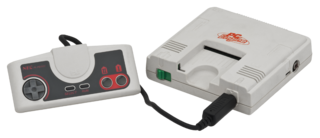PC Engine
From NEC Retro

| ||||||||||
| PC Engine | ||||||||||
|---|---|---|---|---|---|---|---|---|---|---|
| Manufacturer: NEC | ||||||||||
|
This teeny-tiny article needs some work. You can help us by expanding it.
The PC Engine (PCエンジン) is a video game console originally released by NEC in Japan in October 1987. It stands as NEC's first foray into the lucrative video games market, becoming a joint venture with Hudson Soft, creator of the system's primary form of media, the HuCard. It was designed primarily to compete with Nintendo and its immensely popular Famicom machine, though found itself up against more powerful systems such as the Sega Mega Drive and Super Famicom.
Prior to the PC Engine's launch, NEC had gained experience and a large market share in the home computer market primarily with its PC-8800 series and PC-9800 series.
Contents
Hardware
For a while, the PC Engine held the record for the smallest video game console ever produced - a white box with a single controller port, power switch and HuCard slot for playing games.
Technical Specifications
History
Development
In the late 1970s and early 1980s, the Japanese electronics industry was experiencing rapid growth, and with it, an increased adoption of something once out of the price range of most ordinary people - the personal computer. It was a market that NEC, like many electronics giants, wished to capitialise on, and starting with the PC-8000 series in 1979, the company gained a foothold in both the consumer and commercial sectors when it came to computing.
Then, in 1983, toy manufacturer Nintendo launched its Family Computer, or "Famicom" - a dedicated video game console which would go on to dominate a new found market for much of the 1980s. What was initially viewed as a novelty became a business of its own - consumers unable or unwilling to deal with expensive, "everyman" computers flocked to Nintendo's machine, particularly younger demographics who had no desire for the latest typewriter or spreadsheet packages.
Meanwhile Hudson Soft had been working on what it thought was groundbreaking technology - storing software not on expensive ROM cartridges or the unreliable nature of magnetic floppy disks or compact cassettes, but on a "card". Originally tested on the MSX range of computers as the "Bee Card", Hudson tried to sell the technology to Nintendo but were turned down. They then went to NEC, struck a deal, and work began on a rival console around 1985/1986.
The so called PC Engine, whose name was derived from NEC's successful PC-xx range, was developed as a more powerful alternative to the Famicom (and Sega Mark III, the Famicom's closest contender released in 1985). NEC would make the hardware, Hudson Soft would make the software, and as Nintendo were yet to announce a successor to its aging console, the plan was to take the lion's share the video games market.
The NEC/Hudson plan was to create a console that was sleek and compact, as opposed to looking like a "toy". To this day the PC Engine stands as the smallest console ever released.
At the very least, talks of better specifications and less restrictive development practises caught the eye of arcade developers such as Namco, and the system was launched in late 1987.
Release
The PC Engine was a big success, and was the best selling console in 1988, dethroning Nintendo and fending off challenges from Sega in its Master System and Mega Drive consoles. Following this victory NEC looked to the future, releasing the CD-ROM² in December which in turn made the PC Engine the first console to support CD-ROM-based media.
A hiccup came in the form of the SuperGrafx when details of a proposed Super Famicom began to emerge, but life continued to be kind to NEC through 1989, leading to the start of a wobbly relationship of a localised version of the console, the TurboGrafx-16, for North America.
The launch and subsequent success of the Super Famicom led to NEC launching the PC Engine Duo, and alongside the redesigned PC Engine CoreGrafx and later PC Engine CoreGrafx II, the original model was discontinued.
NEC notoriously changed its mind several times over the idea of selling the PC Engine in Europe, but while the UK and Spain eventually saw the console in the form of the TurboGrafx, France was given a supply of slightly modified PC Engine consoles through a locally-formed distributor, Sodipeng.
Legacy
While never a market leader, the PC Engine was a huge success in Japan, comfortably fending off Sega and its challenger in the Sega Mega Drive (and later Sega Mega-CD), but being put under pressure with Nintendo's Super Famicom in the early 1990s. As well as being the logical home for games produced by Hudson Soft, it became the system of choice for other developers such as Namco.
However, its Japanese success was never successfully emulated elsewhere, trailing a distant third behind Nintendo and Sega in the form of the TurboGrafx-16 or TurboGrafx. As such, while its impact on the Japanese gaming market is significant, the console was largely unheard of in the Western world until the advent of easily accessible internet connections.
NEC tried to succeed the PC Engine with the PC Engine SuperGrafx, and then again with the PC-FX. Neither system saw the same level of success.
Physical scans
| PC Engine |
|---|
| PC Engine (1987) | CoreGrafx (1989) | CoreGrafx II (1991) X1 Twin (1987) | PC-KD863G (1988) | Shuttle (1989) | GT (1990) | LT (1991) |
| Add-Ons |
| AV Booster (1988) | Interface Unit (1988) | Ten no Koe 2 (1989) | Backup Booster (1989) | Backup Booster II (1989) | Ten no Koe Bank (1991) | Memory Base 128 (1993) |
